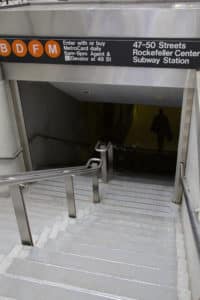

Train and subway platforms, staircases and common areas are used by millions of people every day. As a result, train and subway operators are required to provide a safe environment that is regularly inspected, maintained and repaired. When train and subway stations are not cared for properly, and injury results, there may be a basis to file a claim for damages. Here are some important things you need to know if you were injured in a train station.
Who Owns and Operates the Train Stations in New York City?
The New York City transit system is owned by the City of New York, but operated by the New York City Transit Authority. The New York City Transit system is one of the largest transit operating systems in the world, with over 470 individual stations. Each of these stations is equipped with train platforms, staircases, lighting as well as other component parts that require ongoing maintenance. This work is usually performed by New York City Transit workers, although sometimes contractors are hired by the Transit Authority as well.
Not every train system that operates in New York City, however, is operated by the New York City Transit Authority. In fact, there are many different train operators throughout the City of New York. For example, Metro North train stations, which are used daily by New Yorkers, are operated by Metro North Commuter Railroad and not New York City Transit Authority. Trains are also operated by Amtrak and Long Island Railroad as well. It is important to understand who operates a particular train system because the filing requirements for claims against the New York City Transit Authority, Metro North Commuter Railroad, and Amtrak are all different.
What Obligations Does A Train Operator Have To Keep Train Stations Safe?
The owners and operators of train stations must keep their stations reasonably safe. Just like any other property owner, the owners and operators of a train station have a duty to regularly inspect, maintain and repair the station to protect the public from dangerous conditions. When they fail
In addition to proving that the condition was not reasonably safe, you are also required to prove that the defendant was aware of the problem before the accident happened but failed to correct it. This is known as the notice requirement. It is not necessary to prove that the owner actually knew about the dangerous condition before the accident. If the condition was present for a long enough period of time that the owner should have known about, this can establish notice as well. You can also establish notice by demonstrating that the owner created the dangerous condition.
Some common conditions that cause train station accidents include:
- broken steps that create trip and fall accidents;
- defective handrails that are loose or give way;
- leaks that create slipping hazards on train platforms and staircases;
- elevator or escalator malfunctions that cause injury.
Are There Any Special Filing Requirements for Accidents That Happen at a Train Station?
Accidents that happen at train stations usually require the filing of a Notice of Claim because train stations are usually owned and operated by a municipality. A Notice of Claim is a legal document that must be filed within 90 days of the incident. The Notice of Claim must have specific details concerning the accident as well as the claimant’s signature. After filing the Notice of Claim, the New York City Transit Authority will request a hearing and ask the claimant questions about the accident and injuries. The municipality may also request that a doctor examine the claimant.
Only after completing all of these preliminary steps can you file a lawsuit. The time limit, or statute of limitation, for a lawsuit against the New York City Transit Authority is usually one year and 90 days.
Lawyers24-7.com | Ask Questions – Get Answers
If you sustained an injury in a train station, contact our experienced train accident attorneys for a free consultation by calling (800) 762-9300. You can also fill out a case intake form, and we will have one of our attorneys get right back to you.
You Might Also Be Interested In:

